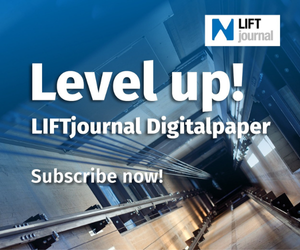Digital logbook for lifts
What maintenance company hasn’t had this problem? You would like to have a history of the lift, know what parts have been installed or what parts have already been replaced? Every time, you have to start from scratch…
Lifts are repeatedly started to record or measure the same parts? In this way, precious working hours are wasted every day for car trips and repeated, identical processes. But now there is a way to greatly reduce the working time and as a result make more effective use of personnel resources.
IT solutions for lift companies
FLP, based in Fellbach near Stuttgart, now also provides IT solutions for lift companies. The services offered are based on software for smartphones and are supposed to simplify typical processes for lift companies. The goal is optimisation of working time so that not only are costs reduced, but the turnover of the lift company is also boosted.
LiftLog is a digital logbook for lifts in which results are recorded and digitalised by smartphones. All data and events recorded can be permanently retrieved with external data access.
Elements of the IT solution
- A basic app for the smartphone
- Forms that are installed inside the basic app
- A backend that is accessed via a browser
Mode of operation of the logbook
To use the logbook, a QR code is printed on a label so that it can be attached to the lift. At the same time, you receive a logbook card, which can also be attached to the lift or filed. This includes all important information about the lift and how to access the logbook.
A smartphone with an IOS or Android operating system is needed to install the logbook. The employee scans the code attached at the lift with a QR scanner and gets an installation instruction.
The app can be launched and used immediately. After recording the data, the data set is sent to a back office as a PDF file in an e-mail. The data can undergo further processing there. At the same time, the data is archived in the digital logbook and can be retrieved from a backend protected by a password.
Components of the data recording
The menu guidance first offers a review of the lift data and the factory number. After this, the following data can be recorded:
- work certificates
- record of materials installed
- record of defective components
- malfunction reports
- record of lift data
- record of components
- record of other items
- signature fields for fitter and customer
The building blocks used in recording the data are text modules, selection fields, photos, speech recordings, GPS data and a signature field.
Advantages for lift companies
LiftLog is more than just a collection of digital data. The logbook maps several processes simultaneously and archives it in a cloud thanks to modern technology. Time-saving and efficient use of personnel resources are the greatest advantage here. Given thorough advice from an IT consultant, processes can in this way be optimised and improved.
The logbook for lifts is just one of the various IT solutions FLP has presented this year. More services are to be offered and presented in future. You can find details on the logbook for lifts at www.aufzug-logbuch.de.
www.flp-shop.com






















Write a comment